The True Likeness of a Princess?
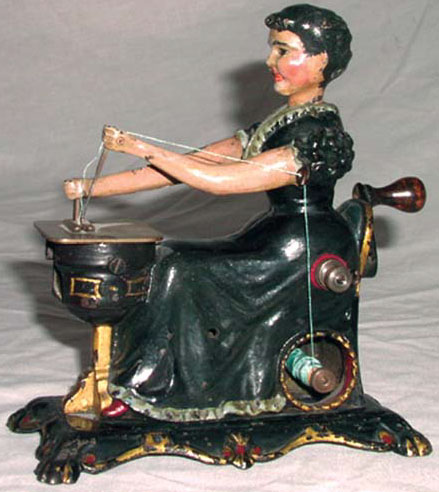
figure 1
The new Sandt 'Princess' figural
In July 2006 a cast iron, figural toy sewing machine toy in excellent condition turned up at an auction . . .
To own one of these figural machines is probably every toy sewing machine collector's goal, so naturally I was very interested. At first glance I thought this machine was similar to the 1890s Max Sandt designed machine popularly known as the Nürnberg Lady or Nürnberg Princess, but with different painted decoration. A closer inspection, however, revealed that it was a totally different casting and colour combination (Figure 1).
Sandt's figural machines appeared on the market around 1893-4. A diagram from his original patent application is shown in Figure 2. A bit of production history is relevant here but, rather than provide an inexpert account, it is better to quote directly from Peter Wilhelm's authoritative book on old German sewing machines (my translation):
"In the October 1891 Max Sandt from Bielfeld patented his Figural sewing machine, the Princess. Sitting figures – an ape, policeman, woman or clown - gave these sewing machines an unmistakable form. However, these sewing machines were produced and sold not by Sandt, but by the "Patent Waagenfabrik" (literally 'patent balances factory') of the purchasers, Eduard Steinfeld and Friedrich Blasberg, in Hanover. They praised their new children's sewing machine to dealers subscribing to the DNZ (Deutsche Nationalzeitung) of June 1893, describing it as a possible 'Christmas novelty'.

figure 3
The Nürnberg 'Lady'
The production of the Princess must therefore have begun in 1893. However it is also clear that only two announcements (of the machine) ever appeared, one in the 'DNZ' and one in 'Lind's Sewing Machine Technicians'. This indicates that the demand was probably very small and that production was promptly adjusted."
Basically, therefore, these beautifully made figural toys did not prove as popular as expected and were on the market for only a very short time; hence their comparative rarity today.
Two Sandt figural machines are well known in today's collections: the 'Nürnberg Lady/Princess' and the 'Nürnberg Clown'. Both are very rare and highly prized. (A 'Clown' sold at the ISMACS AGM auction in 1996 for £8 000: see issues 51 & 52 of ISMACS News). The 'Clown' and 'Lady' probably occur in roughly equal numbers. The 'Lady/Princess' machine is often decorated with a red dress and blonde hair (Figure 3); the 'Clown' usually has either a pale blue or a red hat and suit (Figure 4).
As a result of the recent find there are now two distinct forms of female figural, the old and the new. Apart from being a different casting, the new female figural machine is a curly headed brunette in a black dress with pale blue lacy trim and short sleeves.
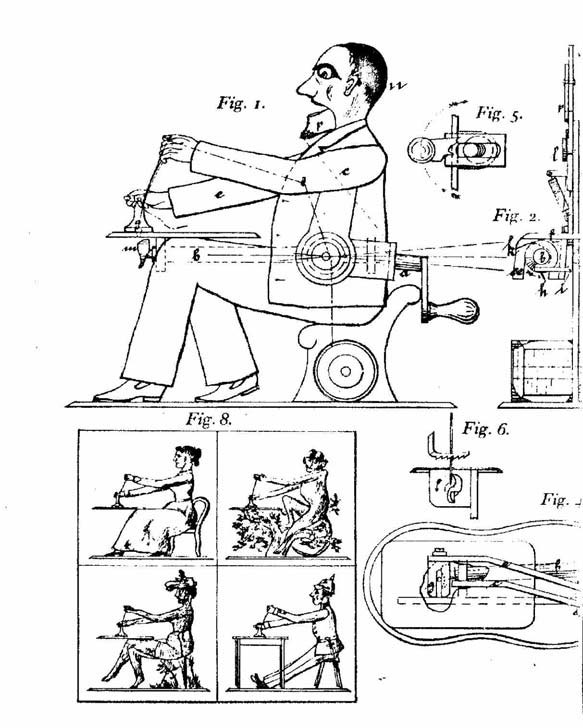
figure 2
Part diagram of Sandt's patent application of 1891 (Courtesy Peter Wilhelm)
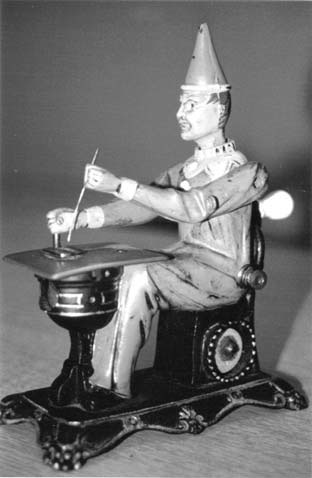
figure 4
The Nürnberg 'Clown'
So which one is the 'Princess'? Well, Peter Wilhelm's book (page 156) provides an engraving of the 'Princess' from one of the 1893 advertisements (Figure 5). It clearly shows the figure of a young woman with a distinctive hairstyle and a short sleeved dress. The machine illustrated in Peter's book is also very similar to the one that has recently turned up at auction (Figure 1). This suggests that the newcomer is the true 'Princess'; and that the somewhat more mature figure with the long-sleeved red dress, shown in Figure 3, is the 'Lady'.
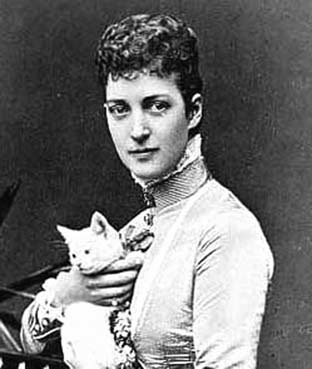
figure 6
Picture of the young HRH Princess Alexandra (From a popular 'carte de visite' photo of the mid to late
1800s)
A tantalising question is: are there any other examples of this 'Princess' machine out there? If you do know of one, please contact me. Certainly, experience of the last decade has shown that, when a machine is claimed to be unique, more examples often turn up! To my knowledge, no other 'Princess' machine has been reported to date. Therefore, probably very few were made, and the limited production run of these figurals probably concentrated on the 'Clown' and the 'Lady'.
Another question is: where did Sandt's original idea for his 'Princess' machine come from? Here I have a firmer suggestion. The picture shown in Figure 6 is that of Princess Alexandra of Denmark. In 1863 she married the (British) Prince of Wales (later Edward VII) and thus became Britain's future Queen Alexandra. Is this, then, the true likeness of Max Sandt's 'Princess'?
And from where did the newly discovered 'Princess' machine come, before it appeared at auction? It came from the famed Doll Collection of the Legoland Museum at Esbjerg, in Denmark...
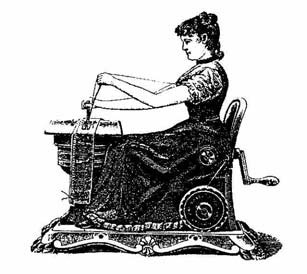
figure 5
Illustration of Sandt's 'Princess' machine from the 1893 advert in Deutsche Nationalzeitung (No. 6, June
1893, page 10) (Courtesy Peter Wilhelm)
Wilhelm, Peter (2002). Alte Nähmaschinen. Mecke Drucke und Verlag Duderstadt, 240 pp. ISBN 3-932752-87-2.






